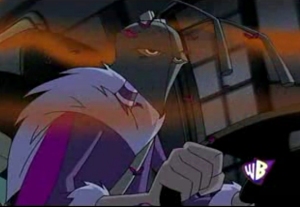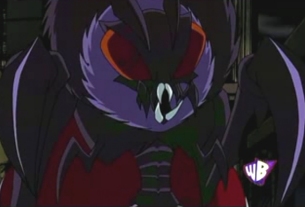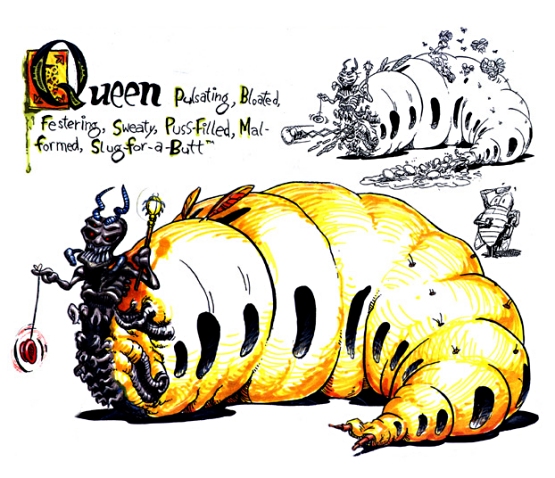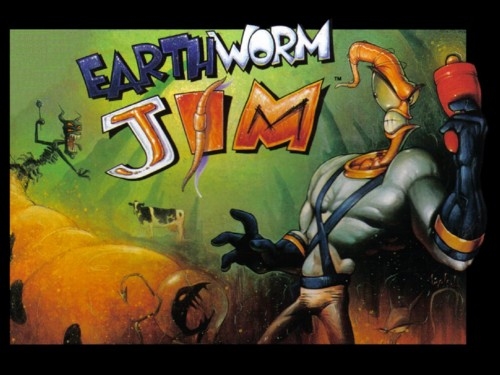| THE TOP TEN EVIL BUGS - PART ONE |
| #10 - Evil Queen Pulsating, Bloated, Festering, Sweaty, Pus-filled, Malformed, Slug-for-a-Butt (Earthworm Jim) |
As a life-long fan of monsters, villains, and arthropods, it was inevitable I write something on my website about
monstrous, villainous arthropods through the ages. Appearing extremely alien to our sensibilities, lurking in
places we can easily overlook and outnumbering us millions to one, insects and arachnids have been the
inspiration for villains, ghouls and demons since the dawn of storytelling.
Characters from video games, folklore, literature and cinema were all eligible in this countdown, but only those
with the physical, biological characteristics of arthropoda. Characters with merely the insect-like costumes or
mutant spider powers hardly count as "bugs."
monstrous, villainous arthropods through the ages. Appearing extremely alien to our sensibilities, lurking in
places we can easily overlook and outnumbering us millions to one, insects and arachnids have been the
inspiration for villains, ghouls and demons since the dawn of storytelling.
Characters from video games, folklore, literature and cinema were all eligible in this countdown, but only those
with the physical, biological characteristics of arthropoda. Characters with merely the insect-like costumes or
mutant spider powers hardly count as "bugs."
Created by wacky writer and artist Doug TenNapel, Earthworm Jim was an ordinary annelid given
superhuman strength and almost-human intelligence when a mysterious suit fell from space and landed him in
an outlandish intergalactic adventure against such peculiar foes as Professor Monkey-for-a-head, Major
Mucus and Evil the Cat. Baddest of all, however, was the suit's rightful owner; the Evil Queen Pulsating,
Bloated, Festering, Sweaty, Pus-filled, Malformed Slug-for-a-Butt, seen here on the left of the SNES cover art.
superhuman strength and almost-human intelligence when a mysterious suit fell from space and landed him in
an outlandish intergalactic adventure against such peculiar foes as Professor Monkey-for-a-head, Major
Mucus and Evil the Cat. Baddest of all, however, was the suit's rightful owner; the Evil Queen Pulsating,
Bloated, Festering, Sweaty, Pus-filled, Malformed Slug-for-a-Butt, seen here on the left of the SNES cover art.
Slug-for-a-Butt ruled with tyranny over the planet Insectika, home to the wasp-like Zurb. She was actually
hatched along with a kind-hearted twin sister, Princess Whats-her-name, but the princess was a hideous
monster by Zurb standards and Slug-for-a-Butt would default to ruler. Employing all manner of weird alien
minions, the Queen would be a formidable enemy in both the original video game and the cheesier cartoon
series.
IN THE REAL WORLD: termite queens develop an extra pair of ovaries each time they molt, adding to the
length of their immense, worm-like abdomen. They can live for up to fifty years, produce over a thousand eggs
a day and mate continuously with a tiny "king" termite.
hatched along with a kind-hearted twin sister, Princess Whats-her-name, but the princess was a hideous
monster by Zurb standards and Slug-for-a-Butt would default to ruler. Employing all manner of weird alien
minions, the Queen would be a formidable enemy in both the original video game and the cheesier cartoon
series.
IN THE REAL WORLD: termite queens develop an extra pair of ovaries each time they molt, adding to the
length of their immense, worm-like abdomen. They can live for up to fifty years, produce over a thousand eggs
a day and mate continuously with a tiny "king" termite.
| #9 - Brain Bugs (Starship Troopers) |
In Robert A. Heinlein's science fiction novel "Starship Troopers," man is at war with a race of spider-like,
technological aliens referred to as "pseudo-arachnids," ruled by a specialized caste so bloated with grey
matter that they can scarcely move. These "brain bugs" are virtually all that survives the transition from book
to cheesy action flick, with the rest of the movie bugs reduced (or is it enhanced?) to massive, animalistic
monstrosities. Only the Brain Bugs are portrayed as fully sentient, and can suck the brains from another living
being to absorb even more knowledge. Too awkward to move about on their own, they are ferried along by
swarms of skateboard-sized, cockroach-like "chariot bugs."
The Brain Bugs command vast legions of warriors that could snip a small car in half, elephantine beetles that
spew magma-like acid and "plasma bugs" who launch bug-infested meteorites to other planets. It didn't stop
the movie's specimen from getting captured and face-probed by the military, but it's not too shabby.
IN THE REAL WORLD: there aren't any!!!
technological aliens referred to as "pseudo-arachnids," ruled by a specialized caste so bloated with grey
matter that they can scarcely move. These "brain bugs" are virtually all that survives the transition from book
to cheesy action flick, with the rest of the movie bugs reduced (or is it enhanced?) to massive, animalistic
monstrosities. Only the Brain Bugs are portrayed as fully sentient, and can suck the brains from another living
being to absorb even more knowledge. Too awkward to move about on their own, they are ferried along by
swarms of skateboard-sized, cockroach-like "chariot bugs."
The Brain Bugs command vast legions of warriors that could snip a small car in half, elephantine beetles that
spew magma-like acid and "plasma bugs" who launch bug-infested meteorites to other planets. It didn't stop
the movie's specimen from getting captured and face-probed by the military, but it's not too shabby.
IN THE REAL WORLD: there aren't any!!!
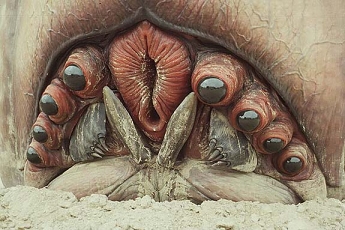
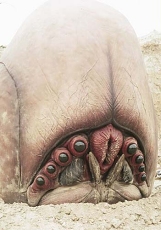
| #8 - Swarm (Marvel Comics) |
Surprisingly one of the only insect-themed villains in Spider Man's rogues gallery, the terrifying Swarm was
once Fritz Von Meyer, a brilliant scientist working for none other than Adolf Hitler. After the war, he kept a low
profile as a beekeeper until discovering a colony of the insects that had mutated under exposure to cosmic
radiation. When the super-intelligent insects turned on him, they devoured his flesh and collectively absorbed
his intelligence, becoming a new being with thousands of tiny bodies bound to a human skeleton. He would
later lose this last vestige of humanity and take on a form of pure, solid bees...though still bearing eyes and
teeth for no real reason other than how cool it looks.
IN THE REAL WORLD: though Eusocial (colony-forming) bees are the most famous and economically
significant, the majority of bee species are solitary creatures that reproduce without dependence on a "queen."
Many species are stingless, and few produce honey.
once Fritz Von Meyer, a brilliant scientist working for none other than Adolf Hitler. After the war, he kept a low
profile as a beekeeper until discovering a colony of the insects that had mutated under exposure to cosmic
radiation. When the super-intelligent insects turned on him, they devoured his flesh and collectively absorbed
his intelligence, becoming a new being with thousands of tiny bodies bound to a human skeleton. He would
later lose this last vestige of humanity and take on a form of pure, solid bees...though still bearing eyes and
teeth for no real reason other than how cool it looks.
IN THE REAL WORLD: though Eusocial (colony-forming) bees are the most famous and economically
significant, the majority of bee species are solitary creatures that reproduce without dependence on a "queen."
Many species are stingless, and few produce honey.
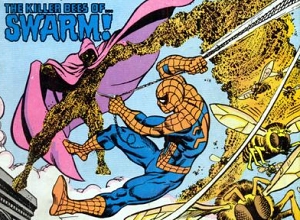
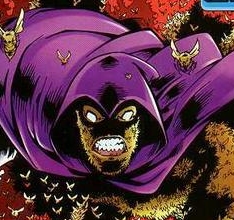
| #7 - Zorak (Space Ghost) |
Created in the late 60's by Hanna Barbera, "Space Ghost" was a low-budget animated superhero whose
formulaic adventures were practically interchangeable with the related Mighty Mightor, Birdman, The Galaxy
Trio and many more. Space Ghost and his sidekicks (including a pet monkey) would take on dozens of
one-shot robots, aliens and other menacing space-terrors, but the mantis-like Zorak, a cold and calculating
menace, would appear more than once and play a significant role in the multi-part series finale.
formulaic adventures were practically interchangeable with the related Mighty Mightor, Birdman, The Galaxy
Trio and many more. Space Ghost and his sidekicks (including a pet monkey) would take on dozens of
one-shot robots, aliens and other menacing space-terrors, but the mantis-like Zorak, a cold and calculating
menace, would appear more than once and play a significant role in the multi-part series finale.
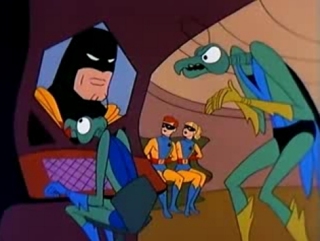
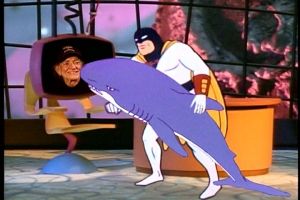
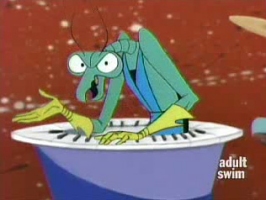
This campy, short-lived series could have easily been the end for these characters, but in 1994, Cartoon
Network debuted the incredibly surreal Space Ghost Coast to Coast, an absurdist late-night talk show where
the spacefaring hero interacted with real-world celebrity guests. Zorak was cast as the talk show's lead
musician, but retained both his love of crime and loathing of Space Ghost. Now portrayed as a maniacally
sadistic, belligerent sociopath, Zorak successfully managed to be far more malicious as a keyboardist than he
ever was as an intergalactic warlord.
Network debuted the incredibly surreal Space Ghost Coast to Coast, an absurdist late-night talk show where
the spacefaring hero interacted with real-world celebrity guests. Zorak was cast as the talk show's lead
musician, but retained both his love of crime and loathing of Space Ghost. Now portrayed as a maniacally
sadistic, belligerent sociopath, Zorak successfully managed to be far more malicious as a keyboardist than he
ever was as an intergalactic warlord.
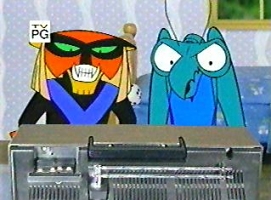
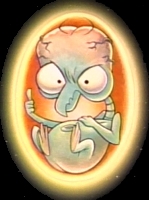
"Space Ghost Coast to Coast" would subsequently spawn more than one spin-off comedy, including "Cartoon
Planet" for younger audiences and "The Brak Show" for Cartoon Network's Adult Swim. Zorak was featured in
the central cast of both, and ranged from schoolyard bully to bloodthirsty psychopath.
IN THE REAL WORLD: though a mantis will devour any conveniently located insect when sufficiently hungry,
cannibalism is not a natural part of their mating process. The vast majority of males evade the larger female's
hungry grasp, and may even bring her pre-caught prey as a safety measure.
Planet" for younger audiences and "The Brak Show" for Cartoon Network's Adult Swim. Zorak was featured in
the central cast of both, and ranged from schoolyard bully to bloodthirsty psychopath.
IN THE REAL WORLD: though a mantis will devour any conveniently located insect when sufficiently hungry,
cannibalism is not a natural part of their mating process. The vast majority of males evade the larger female's
hungry grasp, and may even bring her pre-caught prey as a safety measure.
| #6 - Killer Moth/Charaxes (DC Comics) |
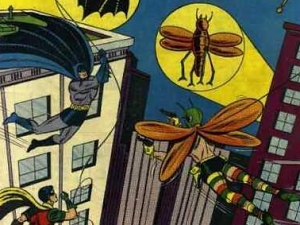
I know I said that merely insect-themed villains are exempt from this list, but the Killer Moth, a DC comics villain,
is only usually human. In his 1951 comic debut, the small-time crook fancies himself a sort of "anti-batman,"
even having his own "moth cave" and "moth signal" in his quest to protect fellow criminals from capture.
Though originally played straight as a viable nemesis for the caped crusader, the Killer Moth's extremely
non-threatening motif was doomed to become an in-joke from the very beginning, and eventually made him a
laughingstock among both comic fans and his fellow in-universe villains. Somebody forgot to tell Killer Moth
that moths are a dietary staple for the vast majority of the world's bats, and dressing like one to commit crimes
in Gotham city is like dressing as a raw salmon fillet to heckle tiger sharks.
is only usually human. In his 1951 comic debut, the small-time crook fancies himself a sort of "anti-batman,"
even having his own "moth cave" and "moth signal" in his quest to protect fellow criminals from capture.
Though originally played straight as a viable nemesis for the caped crusader, the Killer Moth's extremely
non-threatening motif was doomed to become an in-joke from the very beginning, and eventually made him a
laughingstock among both comic fans and his fellow in-universe villains. Somebody forgot to tell Killer Moth
that moths are a dietary staple for the vast majority of the world's bats, and dressing like one to commit crimes
in Gotham city is like dressing as a raw salmon fillet to heckle tiger sharks.
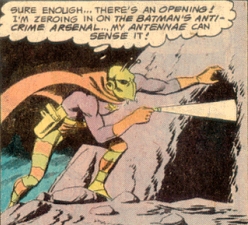
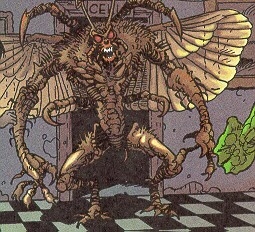
All of this would change nearly fifty years later, with the 1995 debut of "Underworld Unleashed." In the very first
issue of this epic crossover, the then-current Killer Moth (a different criminal from the original) is one of many
minor villains who sell their soul to the demon Neron, essentially Satan, in exchange for greater power.
Through this dubious deal, the comical Killer Moth is supernaturally mutated into a hulking, flesh-eating
demon-moth, able to imprison his prey in inescapable cocoons. Shedding his old identity, he adopts the name
"Charaxes," actually just a very sinister-sounding genus of butterfly.
issue of this epic crossover, the then-current Killer Moth (a different criminal from the original) is one of many
minor villains who sell their soul to the demon Neron, essentially Satan, in exchange for greater power.
Through this dubious deal, the comical Killer Moth is supernaturally mutated into a hulking, flesh-eating
demon-moth, able to imprison his prey in inescapable cocoons. Shedding his old identity, he adopts the name
"Charaxes," actually just a very sinister-sounding genus of butterfly.
Killer Moth would appear as a legitimate threat in Cartoon Network's Teen Titans, with what are either
insect-like characteristics or a very convincing costume. Now a brilliant geneticist, he engineers mutant moths
that terrorize the city by devouring metallic substances. Hilariously, this otherwise impressive villain must
balance his criminal career with being single father to a spoiled, unappreciative teenage daughter.
insect-like characteristics or a very convincing costume. Now a brilliant geneticist, he engineers mutant moths
that terrorize the city by devouring metallic substances. Hilariously, this otherwise impressive villain must
balance his criminal career with being single father to a spoiled, unappreciative teenage daughter.
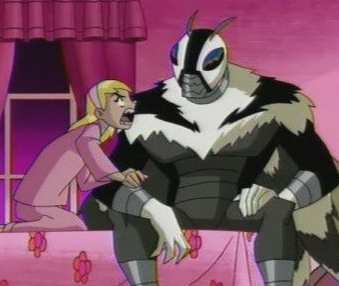
In Warner Brother's animated series "The Batman," Killer Moth appears as a comedically inept, entirely
harmless nerd who finds himself working for the big-time villains as no more than a coffee boy. When
accidentally exposed to toxic chemicals, he takes on a more Charaxes-like appearance - but fully retains his
meek, friendly and oblivious personality.
IN THE REAL WORLD: we often think of moths and butterflies as "day" and "night" counterparts, but butterflies
are only a single, relatively tiny group within the vast order Lepidoptera. What we generally think of as "moths"
are the common default for this order, and can be just as active during the daylight as the butterflies.
harmless nerd who finds himself working for the big-time villains as no more than a coffee boy. When
accidentally exposed to toxic chemicals, he takes on a more Charaxes-like appearance - but fully retains his
meek, friendly and oblivious personality.
IN THE REAL WORLD: we often think of moths and butterflies as "day" and "night" counterparts, but butterflies
are only a single, relatively tiny group within the vast order Lepidoptera. What we generally think of as "moths"
are the common default for this order, and can be just as active during the daylight as the butterflies.
